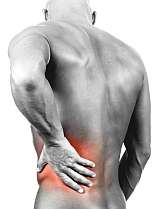| |
| |


|
List
of Diseases > Back pain or Backache
 Back pain, backache or lumbago affecting upper, middle and lower back. Cause and treatment of pain in back with homeopathic remedies and homeopathy treatment for backache. Back pain, backache or lumbago affecting upper, middle and lower back. Cause and treatment of pain in back with homeopathic remedies and homeopathy treatment for backache.
Back pain or backache is defined as pain or discomfort felt in the upper, middle and lower back, arising from structures in the back like muscles, nerves, bones or ligament.
Back is divided into three major parts – upper, middle and lower. Depending upon the location, back pain is classified asUpper Back Pain (affecting the area of cervical and thoracic spine), Middle Back Pain (affecting the area of dorsal spine), and Lower Back Pain or Lumbago (affecting the area of lumbo-sacral spine).
Lower back pain, or lumbosacral pain, is the commonest type of back pain. Low back pain is also known aslumbago.
The backache is also classified according to the duration and intensity of the pain. Generally three type of back pain are there, acute, sub acute and chronic. Acute lower back pain persists for less than 40-45 days, while chronic lower back pain persists over three months and in-between of these two, pain can be defined as sub acute pain.
The pain in back can also be one sided. Left side back pain or right side back pain commonly occour from a muscular sprain, herniated intervertebral disc, or renal calculi. Other causes of one sided back pain are listed below.
The main parts of our back are vertebral column, posterior part of rib cage, scapula and muscles. Our vertebral column or backbone provides support to our body weight. Vertebral column consists of 33 vertebrae. In between vertebras, intervertebral discs are there. Both vertebrae and discs form spinal canal from which, spinal cord passes. Spine also consists of blood vessels, muscles, tendons and ligaments. When all the contents work simultaneously it provides movement to the back.
Back pain or backache can be divided into acute, sub-acute and chronic.
- Acute back pain – This kind of pain is usually sudden in onset, short lasting, often for few days or few weeks, usually occours in lower back.
- Chronic back pain – Long lasting pain which persist for more then 3-4 months; deep, aching dull pain, which may extend to the leg.
- Backache, which persist in-between can be termed as sub-acute pain.
- Diseases of vertebral column – like pott’s spine, tumor, and disk prolapse or herniated intervertebral disk, degenerative disk disease, osteomalacia, osteoporosis, spondylosis.
- Infection of the spinal cord can cause back pain.
- Mechanical cause – includes abnormal posture, injury or trauma, extreme obesity, heavy lifting, sleeping on very soft mattresses.
- Referred pain – of renal calculi, renal tumors, renal tuberculosis, pancreas tumor, diseases related to female genital organs.
- Metastasis – cancer may spread to the bones like breast cancer, lung cancer and causes back pain.
- Compression of nerve may occur due to which the part which receives nerve supply from same nerve can become weak. For example, compression of the lumber nerve restricts the upward movement of the big toe.
- Pain aggravated by movement, prolonged overwork, sitting (but inflammatory pain ameliorated by movement and aggravated by rest).
- Extension of the pain may occur to the other parts of the body especially to the buttocks, back of thigh, calf muscles.
- Sharp pain in the neck and back after lifting heavy objects.
- Difficulty in walking or standing straight due to muscle spasm and stiffness.
- Vertigo or giddiness may occour when the cervical spine is involved.
- Compression of nerve may occur due to which the part which receives nerve supply from same nerve can become weak. For example, compression of the lumber nerve restricts the upward movement of the big toe.
- Pain aggravated by movement, prolonged overwork, sitting (but inflammatory pain ameliorated by movement and aggravated by rest).
- Extension of the pain may occur to the other parts of the body especially to the buttocks, back of thigh, calf muscles.
- Sharp pain in the neck and back after lifting heavy objects.
- Difficulty in walking or standing straight due to muscle spasm and stiffness.
- Vertigo or giddiness may occour when the cervical spine is involved.
- Physical examination -Includes posture, gait, movement, extension of the pain, modalities of the pain, and examination of the related joints like sacroiliac joint.
- Blood test – Culture examination-for osteomylitis, complete blood count, ESR test.
- Bone density examination or densitometry - To detect osteoporosis.
- X-ray spine – To diagnose fracture, decreased bone mass, arthritic changes.
- CT scan-spine, MRI-To detect nerve compression. It can be done in the condition of long continued pain.
- Montoux test – To diagnose tuberculosis as it can cause back pain.
- Bone scan – To detect developing malignant diseases.
- Urine culture – To diagnoses urinary track infection.
Rest should be advised to the patient in the condition of acute back pain. Physiotherapy is often helpful in cases of chronic lumbago. The exact concomitant treatment depends upon the underlying cause and should be done only under the guidance of your doctor.
|
|
All
contents © copyright 2023-24, Dr. R L Khullar,. All rights reserved.
Website Designed and Developed by www.mark-design.net |
|